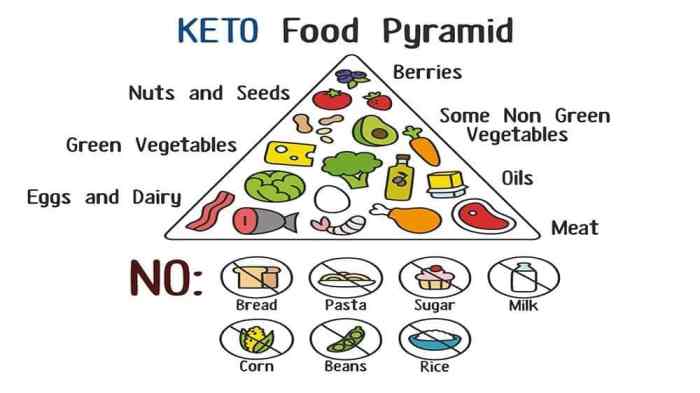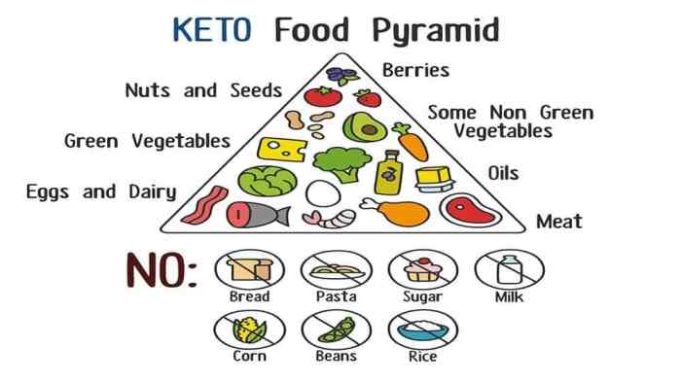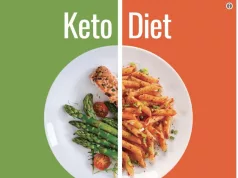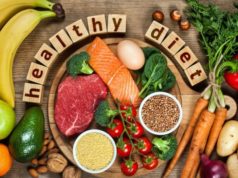How does atkins diet work – How does the Atkins diet work? It’s a low-carb, high-protein weight loss plan that promises quick results by shifting your body into a state of ketosis. This means your body starts burning fat for energy instead of relying on carbohydrates. The Atkins diet consists of four phases, each with progressively increasing carbohydrate intake, aiming to help you lose weight and maintain it long-term.
The Atkins diet has gained popularity for its potential to promote weight loss and improve blood sugar control. However, it’s important to understand the potential risks and consider the long-term sustainability of this approach. This article will delve into the core principles of the Atkins diet, its mechanisms, potential benefits, risks, and practical tips for following it effectively.
Atkins Diet Basics
The Atkins diet is a low-carbohydrate, high-protein weight-loss program that emphasizes the consumption of protein, fat, and limited carbohydrates. It operates on the principle that reducing carbohydrate intake forces the body to burn stored fat for energy, leading to weight loss.
The Four Phases of the Atkins Diet
The Atkins diet is divided into four phases, each with specific guidelines for carbohydrate intake and food choices. The phases are designed to gradually introduce carbohydrates back into the diet while monitoring the body’s response to weight loss and blood sugar levels.
- Induction Phase: This is the most restrictive phase, limiting carbohydrate intake to 20 grams per day. The focus is on protein, fat, and non-starchy vegetables. This phase typically lasts two weeks and aims to initiate rapid weight loss by putting the body into a state of ketosis.
- Ongoing Weight Loss Phase: In this phase, carbohydrates are gradually increased in increments of 5 grams per week until weight loss plateaus. The goal is to find the individual’s “carbohydrate tolerance” level, which is the maximum amount of carbohydrates they can consume without hindering weight loss. This phase can last for several months.
- Pre-Maintenance Phase: This phase focuses on maintaining weight loss by gradually increasing carbohydrate intake while monitoring weight and blood sugar levels. The goal is to determine the optimal carbohydrate intake for long-term weight management.
- Maintenance Phase: This is the final phase, where the individual has reached their ideal weight and maintains it through a balanced diet that includes moderate carbohydrate intake. The focus is on long-term lifestyle changes to sustain healthy weight and prevent weight regain.
Food Groups Allowed and Restricted in Each Phase
The Atkins diet strictly restricts certain food groups while allowing others in varying amounts depending on the phase. Here is a breakdown of the food groups allowed and restricted in each phase:
- Induction Phase:
- Allowed: Meats, poultry, fish, eggs, cheese, low-carbohydrate vegetables (such as spinach, broccoli, cauliflower), nuts, and seeds.
- Restricted: Grains, fruits, starchy vegetables (such as potatoes, corn), sugary drinks, and processed foods.
- Ongoing Weight Loss Phase:
- Allowed: Foods from the Induction Phase, with gradual introduction of low-glycemic fruits (such as berries), some starchy vegetables, and whole grains in limited amounts.
- Restricted: High-glycemic fruits (such as bananas, grapes), sugary drinks, and processed foods.
- Pre-Maintenance Phase:
- Allowed: Foods from the Ongoing Weight Loss Phase, with further gradual increases in carbohydrate intake, focusing on whole grains, fruits, and starchy vegetables.
- Restricted: High-glycemic foods and processed foods.
- Maintenance Phase:
- Allowed: A balanced diet that includes moderate carbohydrate intake, focusing on whole grains, fruits, vegetables, lean protein, and healthy fats.
- Restricted: Processed foods, sugary drinks, and excessive amounts of unhealthy fats.
How the Atkins Diet Works
The Atkins diet, a popular low-carbohydrate weight loss plan, aims to achieve weight loss by drastically reducing carbohydrate intake and promoting fat burning. It operates on the principle that limiting carbohydrates forces the body to utilize stored fat as its primary energy source, leading to weight loss.
The Role of Carbohydrates in Weight Loss
Carbohydrates are a primary source of energy for the body. When consumed, carbohydrates are broken down into glucose, which is used by cells for energy. However, excess carbohydrates can be stored as fat, leading to weight gain. The Atkins diet restricts carbohydrate intake, aiming to reduce glucose levels and force the body to tap into stored fat for energy.
Ketosis and its Impact on the Body
The Atkins diet induces a metabolic state known as ketosis. When carbohydrate intake is severely restricted, the body starts breaking down stored fat into ketones, which are used as an alternative energy source. Ketones are produced in the liver and can be used by the brain and other tissues for energy.
Ketosis is a natural metabolic process that occurs when the body is deprived of carbohydrates.
This process can lead to several changes in the body, including:
- Reduced appetite: Ketones can suppress hunger signals, leading to a decrease in appetite and food cravings.
- Increased fat burning: The body burns stored fat for energy, leading to weight loss.
- Improved blood sugar control: The Atkins diet can help stabilize blood sugar levels by reducing carbohydrate intake, which can be beneficial for individuals with type 2 diabetes.
- Increased energy levels: Some people report experiencing increased energy levels during ketosis due to the efficient use of fat for energy.
Potential Benefits of the Atkins Diet
The Atkins diet has been associated with several potential benefits, including:
- Weight loss: Numerous studies have shown that the Atkins diet can be effective for weight loss, particularly in the short term.
- Improved blood sugar control: The Atkins diet can help stabilize blood sugar levels, making it a potential option for individuals with type 2 diabetes.
- Reduced risk of heart disease: Some studies suggest that the Atkins diet may improve certain risk factors for heart disease, such as cholesterol levels.
- Improved cognitive function: Ketones can be used as an energy source by the brain, and some studies suggest that a ketogenic diet may improve cognitive function in individuals with Alzheimer’s disease.
Potential Risks and Considerations
While the Atkins diet can be effective for weight loss in the short term, it’s essential to consider its potential risks and long-term implications for your health. Like any restrictive diet, Atkins can have side effects, and its long-term sustainability and overall health impact are subject to debate.
Potential Side Effects, How does atkins diet work
The Atkins diet, with its emphasis on drastically reducing carbohydrate intake, can lead to several side effects, including:
- Nutrient Deficiencies: The Atkins diet can restrict essential nutrients like fiber, vitamins, and minerals found in fruits, vegetables, and whole grains. This can lead to deficiencies in vitamins B, C, E, and K, as well as minerals like potassium, magnesium, and calcium. These deficiencies can contribute to fatigue, constipation, muscle cramps, and weakened bones.
- Metabolic Changes: The body’s metabolic response to the Atkins diet can be significant. Initially, the body enters a state of ketosis, where it burns fat for energy instead of carbohydrates. This can lead to weight loss, but it can also cause side effects like fatigue, headache, and bad breath. The long-term effects of ketosis on the body are still being studied.
- Kidney Stones: The high protein intake associated with the Atkins diet can increase the risk of kidney stones. This is because protein breakdown produces waste products that the kidneys need to filter, and a high protein intake can put extra strain on the kidneys.
- Gastrointestinal Issues: The low fiber content of the Atkins diet can lead to constipation, diarrhea, and other gastrointestinal problems. The sudden change in diet can also disrupt the balance of gut bacteria, which is essential for overall health.
- Increased Risk of Heart Disease: Some studies suggest that the Atkins diet may increase the risk of heart disease. This is because the high intake of saturated fat and cholesterol associated with the diet can contribute to plaque buildup in the arteries.
Long-Term Sustainability
The Atkins diet is a restrictive diet that can be difficult to maintain long-term.
- Lack of Variety: The strict limitations on carbohydrates can make it challenging to eat a varied and enjoyable diet over time.
- Social Challenges: The Atkins diet can make it difficult to eat with friends and family who are not following the same plan.
- Potential for Weight Regain: Once people stop following the Atkins diet, they often regain the weight they lost. This is because the diet does not teach healthy eating habits or long-term weight management strategies.
Comparison with Other Diets
The Atkins diet is just one of many popular weight loss diets. It’s important to compare and contrast it with other options to determine which one is right for you.
- Mediterranean Diet: The Mediterranean diet emphasizes fruits, vegetables, whole grains, legumes, nuts, and olive oil. It is considered a healthy and sustainable way to lose weight and improve overall health.
- DASH Diet: The DASH diet is designed to lower blood pressure. It focuses on fruits, vegetables, whole grains, and low-fat dairy products.
- Weight Watchers: Weight Watchers is a popular program that uses a point system to help people lose weight. It encourages healthy eating habits and physical activity.
- Intermittent Fasting: Intermittent fasting involves alternating periods of eating and fasting. It is not a traditional diet but a pattern of eating that can help with weight loss.
Practical Tips for Following the Atkins Diet
Successfully navigating the Atkins diet involves more than just restricting carbohydrates. It requires a strategic approach to meal planning, grocery shopping, and managing cravings. This section provides practical tips and strategies to help you make the Atkins diet a sustainable part of your lifestyle.
Meal Planning and Grocery Shopping
Meal planning is crucial for staying on track with the Atkins diet. By planning ahead, you can ensure you have healthy and satisfying meals readily available, reducing the risk of impulsive choices.
- Create a Weekly Meal Plan: Dedicate some time each week to plan your meals. This helps you stay organized and avoid last-minute decisions that might lead to unhealthy choices.
- Stock Your Pantry with Atkins-Friendly Staples: Ensure your pantry is well-stocked with Atkins-friendly staples like lean protein sources (chicken, fish, tofu), low-carb vegetables (broccoli, spinach, cauliflower), and healthy fats (olive oil, avocado).
- Prioritize Whole Foods: Opt for whole, unprocessed foods whenever possible. These are naturally lower in carbohydrates and richer in nutrients.
- Read Food Labels Carefully: Pay attention to the carbohydrate content of packaged foods. Even seemingly healthy options can be high in carbs.
- Plan for Social Events: Anticipate social events where food might be a challenge. Pack your own Atkins-friendly snacks or meals to avoid temptation.
Recipe Ideas for Atkins-Friendly Meals
Here are some recipe ideas that are both delicious and Atkins-compliant:
- Grilled Salmon with Roasted Asparagus: A classic combination of lean protein and low-carb vegetables.
- Chicken Fajita Bowls with Cauliflower Rice: A flavorful and satisfying meal that swaps traditional rice for cauliflower rice.
- Spinach and Feta Omelet: A quick and easy breakfast option that is high in protein and low in carbs.
- Avocado Shrimp Salad: A refreshing and healthy salad that incorporates healthy fats from avocado and protein from shrimp.
- Cauliflower Pizza Crust: A creative way to enjoy pizza while sticking to the Atkins diet.
Managing Cravings and Challenges
Cravings are a common challenge when following the Atkins diet. However, there are strategies to manage them effectively:
- Identify Your Triggers: Pay attention to what triggers your cravings. Is it stress, boredom, or a specific time of day?
- Stay Hydrated: Sometimes, thirst can be mistaken for hunger. Drink plenty of water throughout the day to keep your body hydrated and your cravings in check.
- Focus on Protein and Fiber: Protein and fiber help you feel full and satisfied, reducing the likelihood of cravings.
- Allow for Indulgences: While the Atkins diet emphasizes low-carb eating, it’s okay to have occasional indulgences. Choose Atkins-friendly treats like sugar-free dark chocolate or a small piece of fruit.
- Seek Support: Talk to your doctor or a registered dietitian for guidance and support. They can help you develop a personalized plan and address any challenges you encounter.
Consulting a Healthcare Professional: How Does Atkins Diet Work
While the Atkins diet has gained popularity, it’s crucial to consult a healthcare professional before embarking on this dietary journey. A healthcare professional can provide personalized guidance and ensure the Atkins diet aligns with your individual needs and health conditions.
The Importance of Professional Guidance
Seeking professional advice is paramount for several reasons:
- Personalized Diet Plan: A healthcare professional can help you tailor the Atkins diet to your specific needs, considering factors like your age, weight, medical history, and any underlying health conditions. They can adjust the phases and carbohydrate limits to suit your body’s unique requirements.
- Potential Risks and Interactions: The Atkins diet, like any dietary change, can have potential risks and interactions with medications. A healthcare professional can assess these risks and guide you on how to mitigate them.
- Monitoring and Adjustments: Regular checkups with your healthcare provider are essential to monitor your progress and make necessary adjustments to the Atkins diet. They can ensure you’re staying on track and address any potential issues that may arise.
Potential Risks of Self-Treating with the Atkins Diet
Self-treating with the Atkins diet without professional guidance can lead to several risks:
- Nutrient Deficiencies: The Atkins diet restricts certain food groups, potentially leading to deficiencies in essential nutrients like fiber, vitamins, and minerals. This can have negative consequences for your overall health.
- Kidney Stones: High protein intake, a hallmark of the Atkins diet, can increase the risk of kidney stones in susceptible individuals. This risk is further amplified in individuals with pre-existing kidney conditions.
- Gastrointestinal Issues: The Atkins diet can cause gastrointestinal issues like constipation, diarrhea, and bloating, especially during the initial phases. These issues can be exacerbated if you’re not following the diet properly.
- Long-Term Health Implications: Long-term adherence to the Atkins diet, without proper monitoring and adjustments, may have negative implications for your cardiovascular health and bone density.
Final Thoughts

The Atkins diet can be an effective weight loss strategy for some individuals, but it’s crucial to approach it with caution and seek guidance from a healthcare professional. By understanding the principles, potential benefits, and risks associated with the Atkins diet, you can make an informed decision about whether it’s right for you. Remember, individual results may vary, and a personalized approach is essential for achieving optimal health and well-being.
General Inquiries
Is the Atkins diet safe for everyone?
The Atkins diet might not be suitable for everyone, especially individuals with certain medical conditions. It’s crucial to consult a healthcare professional before starting any new diet, particularly if you have pre-existing health concerns.
Can I exercise while on the Atkins diet?
Yes, exercise is beneficial for overall health and can complement the Atkins diet. However, it’s important to listen to your body and adjust your workout intensity as needed, especially during the initial phases of the diet when your body is adjusting.
How long should I stay on the Atkins diet?
The duration of the Atkins diet can vary depending on individual goals and needs. It’s essential to consult a healthcare professional for personalized guidance on how long to follow the diet and when to transition to a more balanced eating plan.
The Atkins diet is a low-carb, high-protein approach that aims to put your body into a state of ketosis, where it burns fat for energy instead of carbohydrates. This can lead to weight loss, but it’s important to note that it’s a very restrictive diet that might not be suitable for everyone.
To determine your individual caloric needs and macronutrient ratios, you can use a free dieting calculator to personalize your dietary plan. Remember, while the Atkins diet can be effective, it’s essential to consult with a healthcare professional before making any significant changes to your diet.
The Atkins diet, a low-carb approach, works by reducing carbohydrate intake to force your body to burn fat for energy. While this might seem like a straightforward plan, it’s important to consider the role of fiber in your overall health.
Fiber, often lacking in low-carb diets, is crucial for digestion and gut health. Learn more about how to get more fiber in your diet to ensure you’re getting enough even while following a low-carb approach. The Atkins diet emphasizes protein and healthy fats, but a balanced approach that includes adequate fiber can help you achieve your weight loss goals and maintain overall well-being.
The Atkins diet, like many weight-loss plans, focuses on restricting carbohydrates to force your body to burn fat for energy. This can be effective for humans, but it’s important to remember that cats are obligate carnivores and require a different approach to weight management.
If your feline friend needs to slim down, you’ll need to consult with your veterinarian and learn how to put your cat on a diet that meets their unique nutritional needs. While the Atkins diet might work for us, it’s crucial to understand that cats have different metabolic requirements and dietary restrictions.
























